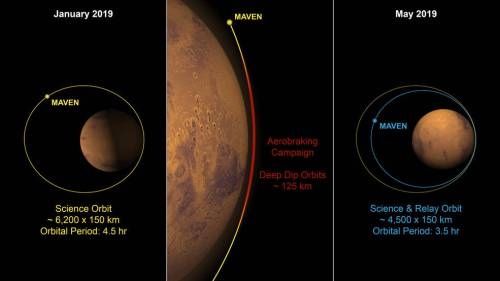A sampling of recent articles, press releases, etc. related to student and amateur CubeSat / SmallSat projects and programs:
** Old Dominion University (ODU) CubeSat completed for the Virginia CubeSat Constellation program (see previous CubeSat Roundup for more about the Virginia Cubesat Constellation initiative): ODU’s CubeSat Moves Closer to Liftoff – News @ ODU
A team of Old Dominion University students took a giant leap toward space as they joined two other Virginia universities in delivering their CubeSats to NanoRacks in Houston on Feb. 26. The nano-sized cube satellites were successfully integrated into the company’s commercially developed NanoRacks CubeSat Deployer (NRCSD) in preparation for launch on Northrop Grumman’s Antares to the International Space Station. The launch is scheduled for April 17 from NASA’s Wallops Flight Facility.
Kimberly Wright, a graduate student in Mechanical and Aerospace Engineering, serves as student mission manager for ODU. She was accompanied by her teammates, Mechanical and Aerospace Engineering master’s student Westin Messer and Electrical Engineering master’s student Anthony Cappiello, as well as their faculty advisor, associate professor of Electrical and Computer Engineering Dimitrie Popescu. Wright was thrilled to finally hand off ODU’s CubeSat for this critical step in a multiyear journey.

** The Alabama CubeSat Initiative will involve about 100 students and faculty from colleges around the state in the developing of CubeSats for deep space missions:
“There have been many student-developed CubeSats previously; to the best of my knowledge, there has never been a student-developed CubeSat to fly outside LEO,” says Dr. Dale Thomas, ASGC director, UAH professor and the eminent scholar in systems engineering. “I think that’s a pretty big deal. And it will be exceptionally challenging.”
On Oct. 16, the Alabama Space Authority passed a resolution supporting the Alabama CubeSat Initiative. The intent of the initiative is to ramp up a system by which ASGC members will eventually fly one collaborative CubeSat per year.
The Initiative is sponsored by the Alabama Space Grant Consortium (ASGC). Commercial support for the program: LogiCore donates $5,000 to help ASGC CubeSat workshop – ASGA
A $5,000 donation from LogiCore Corporation, a logistics and engineering services company in Huntsville Alabama is helping the Alabama Space Grant Consortium (ASGC) to design and build the first in a planned series of statewide collaborative cube satellites (CubeSats).
A recent workshop about the project, which will carry a gamma-ray burst (GRB) detector to be placed in the vicinity of the moon to detect short gamma-ray bursts, was partially sponsored by the LogiCore donation.
** Sydney University’s Centre for CubeSats, UAVs & their Applications (CUAVA) will build two technology demonstration satellites that will be deployed from the Japanese module on the ISS: Sydney Uni partners with Japanese start-up to launch CubeSats – iTnews
The Training Centre for CubeSats, Uncrewed Aerial Vehicles and their Applications (CUAVA) is currently developing two CubeSats to test the uses for cheaper, smaller satellites in the Australian context while developing local expertise in the field.
‘CUAVA-1’ is set to be the first satellite launched later this year, and will be laden with remote sensing, GPS, and communications equipment, along with sensors to monitor the environment in space.
Space BD, who is also a commercial service provider with the Japan Aerospace Exploration Agency, will provide end-to-end launch and deployment services for CUAVA.
** Latest on KickSat-2, which has over 100 tiny ChipSats on board:
We just sent a reset command to #KickSat2 to try re-deploying the antenna. Any help receiving packets in the next few days would be hugely appreciated! @SatNOGS @cgbassa @radiotelescoop @dk3wn @pe0sat @HAMSATNL
— Zac Manchester (@zacinaction) March 8, 2019
** AMSAT news on student and amateur CubeSat/smallsat projects: ANS-069 AMSAT News Service Special Bulletin
- Out of This World Auction Sponsored by ARISS
- AMSAT-F Space Meeting is First Live DATV Conference via QO-100
- GNU Licensed KLog Logbook Software v.0.9.7 Released
- How to support AMSAT
- Upcoming Satellite Operations
- Satellite Shorts from All Over
General CubeSat/SmallSat news & info:
- Ubiquitilink’s Claim Means Every Phone is Now a Satellite Phone – Satnews
- Germany’s Morpheus Space Qualifies World’s Smallest Satellite Propulsion System In Orbit – SpaceWatch.Global
- Hacking Satellites Is Surprisingly Simple – ExtremeTech
- ISIS awarded funding to develop lightweight CubeSat deployer using 3D-printing technology | ISIS – Innovative Solutions in Space
- International collaboration spawns scalable CubeSat EO payloads – Room: The Space Journal
- 6 SmallSat Companies Building and Launching Satellites – Nanalyze
- Spire seeks to expand business with Pentagon – SpaceNews.com
- Orbital Micro Systems Weather Observation Satellite Prepares for Initial Launch April 17 – OMS
- UK radio ham to give Deep Space talk in Belgium | Southgate Amateur Radio News
- Space meeting streaming via ham radio geostationary transponder | Southgate Amateur Radio News
- 2.5 milliwatt OPERA signal via Es’hail-2 | Southgate Amateur Radio News
- UWE-4: First NanoFEEP thruster ignition | Southgate Amateur Radio News
====














